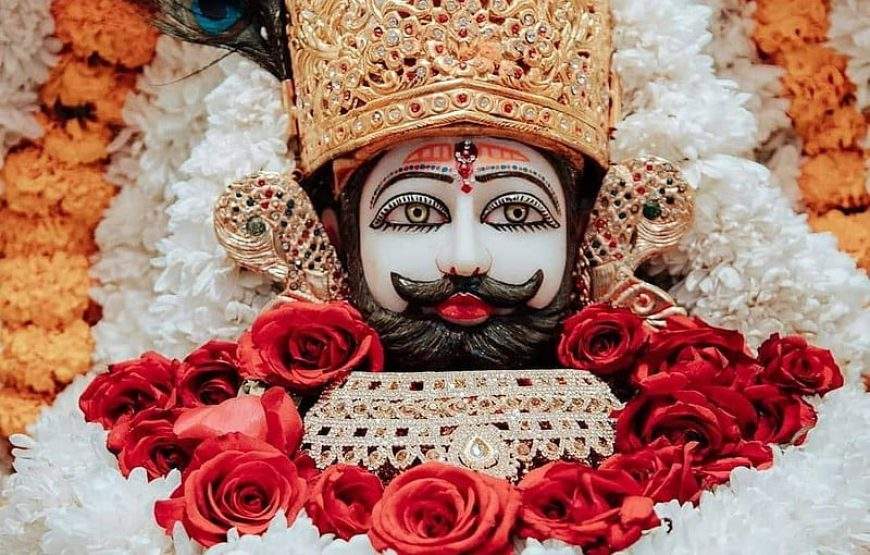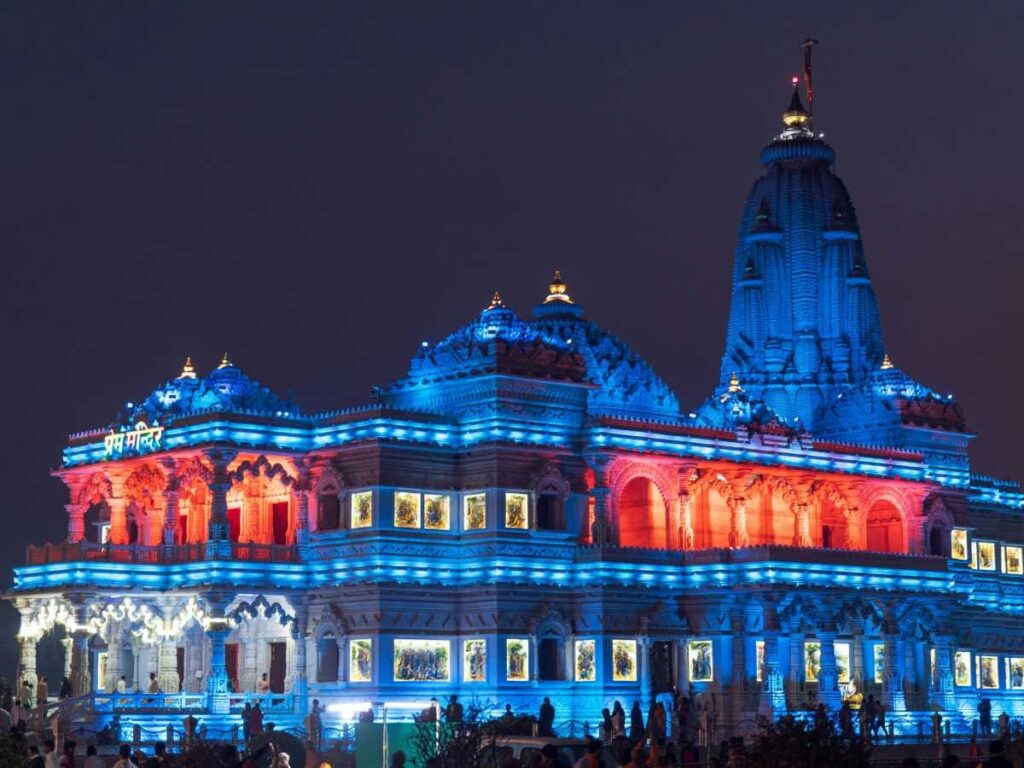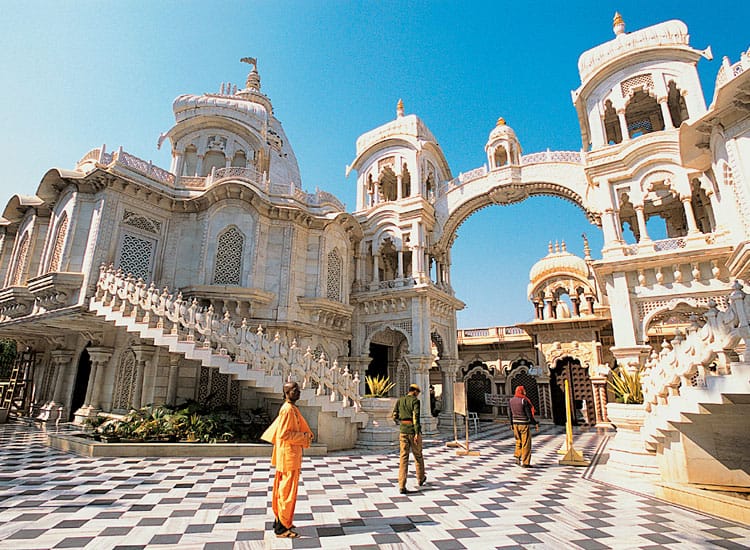
Jaipur ➝ Khatu Shyam Ji ➝ Mehandipur Balaji
1. Khatu Shyam Ji Mandir (Sikar District, Rajasthan)
Khatu Shyam Ji is believed to be the manifestation of Barbarik, grandson of Bhima (Mahabharata).
Barbarik offered his head to Krishna before the Mahabharata war. Pleased, Krishna blessed him to be worshipped as Shyam in Kali Yuga, especially by those in distress.
Known as the “God of Kalyug”, Khatu Shyam listens to sincere prayers and grants wishes.
Especially revered for removing sufferings and giving strength during tough times.
Shyam Kund (sacred pond) nearby, believed to heal illnesses.
Famous Phalgun Mela (Feb–Mar), attracting lakhs of devotees.
2. Mehandipur Balaji Temple (Dausa District, Rajasthan)
Dedicated to Lord Hanuman in the form of Balaji.
Temple is also home to Pret Raj Sarkar and Bhairav Baba, associated with exorcism and healing from black magic/evil spirits.
Known across India for spiritual healing from negative energies.
Devotees perform rituals such as coconut offering, oil donation, and prayer chants.
isitors often observe people undergoing exorcisms or spiritual cleansing.
No prasad is taken back from here.
Devotees often fast or stay silent before and after visiting.
Avoid laughing, mocking rituals, or taking photos.
Don’t touch possessed individuals.
3.Jaipur
Govind Dev Ji Temple (💠 Most Revered)
Deity: Lord Krishna (Govind Dev Ji)
Location: City Palace Complex
Significance: One of the seven original idols of Lord Krishna from Vrindavan.
Specialty: Daily seven aartis, all with immense local devotion.
Best Time: Mangla Aarti (Early Morning), Evening Aarti
Notes: Temple gets filled with chants of “Jai Govind Dev Ji!”
Birla Mandir (Laxmi Narayan Temple)
Deity: Lord Vishnu (Narayan) and Goddess Laxmi
Location: Below Moti Dungri Fort
Significance: Constructed entirely with white marble, symbol of purity.
Specialty: Calm ambiance, ideal for prayer, spiritual reading, or quiet contemplation.
Best Time: Early morning or after sunset (beautifully lit).
Moti Dungri Ganesh Ji Temple
Deity: Lord Ganesha
Location: Near Birla Mandir
Significance: Highly wish-fulfilling temple for success and new beginnings.
Specialty: Very crowded on Wednesdays.
Notes: Maharaja of Jaipur brought the idol from Gujarat.
Galta Ji Temple (Monkey Temple)
Deity: Saint Galav, Hanuman, Surya
Location: Galtaji Hills, ~10 km from Jaipur
Significance: Ancient Hindu pilgrimage site with natural springs (kunds) and hermitages.
Specialty: Trekking up to Sun Temple (Surya Mandir) gives breathtaking views of Jaipur.
Notes: Spiritual center for sages and yogis. Also famous for its monkey population.
ISKCON Jaipur (Sri Sri Giridhari Dauji Temple)
Deity: Radha Govind Ji (Krishna & Radharani)
Location: Mansarovar
Significance: Modern, serene, and full of kirtan, meditation, and satsang.
Specialty: Attend bhajans, prasad, Gita classes.
Notes: Great place to purchase spiritual books, Tulsi malas, and satvik snacks.
Akshardham Temple
Deity: Swaminarayan Bhagwan
Location: Vaishali Nagar
Significance: Beautifully designed temple with gardens and peaceful surroundings.
Specialty: Spiritual cleanliness, simplicity, and architecture.
Notes: Attend evening aarti for a calm spiritual experience.
Tarkeshwar Mahadev Temple
Deity: Lord Shiva
Location: Chandpole Bazaar
Significance: One of the oldest Shiva temples in Jaipur.
Specialty: Devotees believe it fulfills wishes when one sincerely prays.
Sun Temple (Surya Mandir)
Deity: Surya (Sun God)
Location: On top of Galta Ji Hill
Significance: Peaceful sunrise and sunset point, great for chanting Gayatri Mantra.
Specialty: Lesser known but deeply peaceful.
Jagat Shiromani Temple
Deity: Lord Krishna, Meera Bai
Location: Amer Town (Near Amer Fort)
Significance: Temple built in memory of Meera Bai, the famous Krishna devotee.
Specialty: Architecture + Bhakti tradition.
Notes: Combine with Amer Fort or Panna Meena Kund visit.
Shila Devi Temple (Amber Fort)
Deity: Shila Mata (Kali form)
Location: Inside Amer Fort
Significance: Powerful goddess temple with roots from Bengal.
Specialty: Visit during Navratri when thousands of devotees come.
Tour Trip Highlight-
- Khatu Shyam Ji
- Mehandipur Balaji Temple
- Govind Dev Ji Temple
- Birla Mandir
- Moti Dungri Ganesh Ji Temple
- Galta Ji Temple (Monkey Temple)
- ISKCON Jaipur (Sri Sri Giridhari Dauji Temple)
- Akshardham Temple
- Tarkeshwar Mahadev Temple
- Sun Temple (Surya Mandir)
- Jagat Shiromani Temple
- Shila Devi Temple (Amber Fort)
Jaipur, Khatu Shyam Ji ,Mehandipur Balaji Itinerary
Day 1: Jaipur → Khatu Shyam Ji → Jaipur
📍Destination: Khatu Shyam Ji (80–90 km from Jaipur)
🕓 4:30 AM – Depart from Jaipur
Start early to attend Mangla Aarti
Carry simple offerings: chadar, coconut, rose garland
🕕 6:00 AM – 8:00 AM – Khatu Shyam Ji Darshan
Bathe at Shyam Kund
Visit main temple and bow before the Barbarika (Shyam Baba) idol
Attend morning aarti if early
🍽️ 8:30 AM – Breakfast in Khatu
Simple satvik food near temple
🛍️ 9:00 AM – 10:00 AM – Local shopping & rest
Shop for spiritual items, souvenirs, and books
Rest in temple corridor or dharamshala briefly
🚗 10:00 AM – 12:00 PM – Return to Jaipur
Optional lunch en route
Reach Jaipur by early afternoon
🔱 Day 2: Jaipur → Mehandipur Balaji → Jaipur
📍Destination: Mehandipur Balaji (Approx. 105 km from Jaipur)
🕕 6:00 AM – Depart from Jaipur
Stay light and pure: no onion/garlic or alcohol day before
Carry coconut, mustard oil, jaggery for offering
🕘 9:00 AM – 11:30 AM – Darshan at Mehandipur Balaji
Visit:
Balaji Temple (Hanuman Ji)
Pret Raj Sarkar
Bhairav Ji
Participate in:
Offering rituals
Silent prayers
Observing spiritual healing sessions
⚠️ Do Not bring prasad back or mock possessed individuals.
🧘♂️ Spend a few minutes in silent prayer for protection and peace.
🍽️ 12:00 PM – 1:00 PM – Lunch at local satvik Bhojanalaya
Stick to light food (no hotel/fast food)
🚗 1:00 PM – 4:00 PM – Return to Jaipur
Take a short break midway if needed
Arrive back by late afternoon




